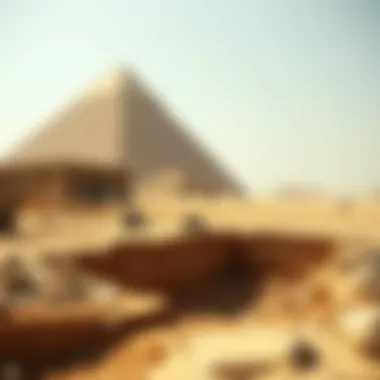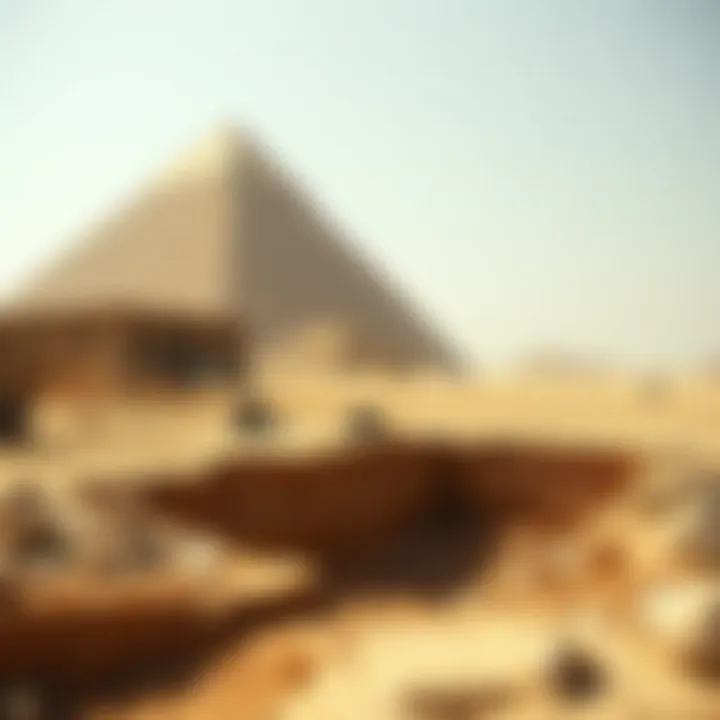Exploring the Great Pyramid of Giza: A Comprehensive Analysis


Intro
The Great Pyramid of Giza, an extraordinary achievement in engineering, stands as a witness to the ingenuity of ancient civilizations. Constructed over 4,500 years ago, it continues to captivate the minds of historians, archaeologists, and enthusiasts alike. This colossal structure not only served as a tomb for the Pharaoh Khufu but also represented the pinnacle of ancient Egyptian engineering and culture. The pyramid's construction techniques, mathematical principles, and alignment with celestial bodies reveal a sophisticated understanding of the world that leaves many awe-inspired.
In this exploration, we aim to peel back the layers of history, delving into the various aspects that make the Great Pyramid a subject of fascination. We'll examine its construction methods, historical context, trivia, and how it remains relevant in today's world. By doing so, we cater not just to scholars and researchers, but to anyone with an interest in this remarkable piece of human achievement.
Historical Context of the Great Pyramid
The Great Pyramid of Giza, constructed during the Fourth Dynasty of Egypt, is more than just a monumental structure—it serves as a the touchstone for understanding the cultural and historical landscape of ancient Egypt. This section delves into the intricate historical context surrounding the pyramid's creation, inception, and enduring significance, emphasizing how these facets contribute to its standing as one of the Seven Wonders of the Ancient World.
Construction Timeline
The timeline of the Great Pyramid's construction is essential for grasping the breadth of its historical backdrop. Built around 2580-2560 BCE, the Great Pyramid was erected over approximately twenty years—a herculean feat for any civilization. Estimates suggest that the construction employed thousands of workers, likely comprising skilled laborers and seasonal workers, with the latter participating during the Nile's inundation.
- Circa 2686-2181 BCE: This entire period marks the Old Kingdom of Egypt, which was characterized by significant architectural achievements.
- 2580-2560 BCE: The Great Pyramid comes to life under the reign of Pharaoh Khufu. Historical estimates imply about 2.3 million blocks of stone were utilized in its construction, sourced mainly from nearby quarries.
- Completion: Upon its completion, the Great Pyramid soared to 146.6 meters, making it the tallest man-made structure in the world for over 3,800 years. This monumental scale was a testament to the capabilities and aspirations of Khufu's reign.
"Pyramids are not just tombs; they are cultural artifacts telling us about the society that built them."
Pharaoh Khufu's Reign
Pharaoh Khufu, known as Cheops to the Greeks, ruled from around 2589 to 2566 BCE. His reign is often linked directly with the Great Pyramid, a reflection of his power and vision. Khufu's desire to secure his legacy and ensure safe passage to the afterlife significantly influenced not only the construction of the pyramid but also the sociopolitical structure of ancient Egypt.
- Political Stability: During Khufu's reign, Egypt enjoyed relative stability, which contributed positively to the resources and manpower needed for such an extensive project.
- Administrative Strength: Khufu's effective governance allowed for the organization of labor, supplies, and the technological innovations that made the pyramid's construction possible.
- Cultural Role: The pyramid's construction was not just a personal ambition for Khufu. It was also a means to unify the kingdom and strengthen the belief in the divine nature of the pharaoh, solidifying the connection between religion and governance in ancient Egypt.
Cultural Significance in Ancient Egypt
The Great Pyramid served not merely as a royal tomb but as a beacon of Egyptian civilization, encapsulating their beliefs, values, and astronomical knowledge. Its design reflects detailed understanding of mathematics and astronomy, which were integral to the religious practices and cultural identity of ancient Egypt.
- Religious Beliefs: The pyramid orientation to the cardinal points and the alignment with astrological entities underscores the Egyptians' spiritual beliefs regarding life after death and the cosmos.
- Symbol of Power: The sheer size and grandeur of the Great Pyramid symbolized the pharaonic power and divine right to rule. It became a point of reference for subsequent pharaohs, potentially influencing their construction endeavors.
- Cultural Identity: Beyond its function as a tomb, the pyramid represents a unifying symbol of the ancient Egyptian people's achievements, aspirations, and their quest for immortality.
Architectural Design and Structure
The architectural design of the Great Pyramid of Giza is more than just a physical structure; it represents a significant achievement in ancient civilization. This section takes a closer look at the intricate details that comprise the pyramid's structure, emphasizing its design, materials, and internal layout. Understanding these components not only sheds light on the engineering skills of the ancient Egyptians but also highlights the cultural values embedded within its design.
Dimensions and Measurements
The sheer size of the Great Pyramid is perhaps one of its most astonishing features. Originally reaching a height of about 146.6 meters, it remained the tallest man-made structure for over three millennia. It's hard to fathom how they managed such feats without modern technology.
- The base of the pyramid covers an area of 13 acres, with each side measuring approximately 230.4 meters. This precise alignment to the cardinal points is evidence of remarkable surveying techniques.
- Measurements indicate that it consists of around 2.3 million blocks of stone, each weighing between 2.5 and 15 tons. This remarkable dimension frequently leads us to speculate about the tools and methods they might have employed in lifting and positioning these massive stones.
Such precise dimensions and meticulous measurements reveal a design that wasn't merely practical but also indicative of symbolic significance, perhaps representing the pharaoh's divine connection to the heavens.
Material Composition
The material used in the construction of the Great Pyramid is integral to its enduring nature. Primarily, the pyramid is composed of limestone, granite, and basalt—each chosen for a specific purpose.
- Limestone: The outer casing was made of Tura limestone, which reflects sunlight and gives an impressive sheen. This was important for the intended afterlife, as the structure was seen as a cosmic representation for the pharaoh's journey.
- Granite: Used primarily in the inner chambers, this hard material symbolizes endurance and strength, essential qualities for a ruler.
- Basalt: Found in various floors, basalt served practical purposes due to its durability and the way it resists erosion.
This careful selection of materials illustrates the builders' advanced choices, emphasizing how every stone and type had a purpose, both for function and symbolism.
Internal Layout
The internal layout of the Great Pyramid is as fascinating as its external form. Unlike a simple tomb, the pyramid incorporates a series of chambers, corridors, and shafts that serve various ceremonial and practical functions.
- The King’s Chamber, made of red granite, houses the sarcophagus of Pharaoh Khufu. Its precise location and design pointed towards a cosmic alignment, suggesting a celestial purpose.
- Below it lies the Queen’s Chamber, which contains subtle features such as air shafts that might have had astronomical significance.
- The Grand Gallery, a monumental hallway that leads to the King’s Chamber, showcases extraordinary engineering. Its corbeled design not only demonstrates structural ingenuity but may also have served as a means to facilitate the ascent of materials and possibly rituals.
The layout of the pyramid reflects not just an architectural marvel but also the deep spiritual beliefs of the Egyptians, evidenced by the thoughtful placement of chambers and corridors meant for the transitions of the afterlife.
In all, examining the architectural elements of the Great Pyramid of Giza provides insight into the capabilities of ancient engineers and their intentions, allowing us to appreciate the depths of human ingenuity and belief systems.
Researching these details can lead to deeper understanding; for further insight, you may refer to resources like Encyclopaedia Britannica or Wikipedia for more accurate technical details.
Construction Techniques


Understanding the construction techniques employed in building the Great Pyramid of Giza is crucial for grasping not just how this ancient wonder came to exist but also the ingenuity behind its design and execution. The methods used by the ancient Egyptians reflect their advanced knowledge of engineering and organization. The Great Pyramid stands as a symbol of their architectural capabilities, showcasing how a landmark of such scale was not just a product of raw materials but of skilled labor and complex planning.
Labor Force and Workforce Organization
The labor force behind the Great Pyramid was nothing short of remarkable. Contrary to popular belief that it was built by slaves, most historians agree that a large group of skilled laborers, possibly numbering in the tens of thousands, worked in rotating shifts. These workers were likely well-fed and housed in nearby settlements, which emphasized the importance of a well-organized workforce in such an extensive project.
This extensive organization was crucial. The managament structure seemingly involved overseers who coordinated tasks, while workers specialized in various roles—stone quarrying, transportation, and assembly. Such division of labor not only optimized efficiency but ensured that the project adhered to time constraints, especially with an ambitious duration of about 20 years for its completion.
- Key Points on Labor Force:
- Large numbers of skilled laborers rather than slaves.
- Workers organized in shifts.
- Specialized roles fostered efficiency.
"Teamwork is the engine that drives success; it burned brightly in the construction of the Great Pyramid."
Tools and Technologies Used
The tools and technologies that the ancient Egyptians employed were surprisingly advanced for their time. The construction of the Great Pyramid relied on a variety of basic yet effective tools. For instance, chisels made from copper or stone were used to carve the massive limestone blocks, while wooden sledges facilitated the transportation of these enormous stones from quarries to the construction site.
In addition, the Egyptians utilized a simple yet innovative method of lubrication, potentially using water or vegetable oil to reduce friction during the dragging of heavy blocks. This method significantly improved efficiency and speed in moving stones up ramps, a technique theorized to have been pivotal in creating the pyramid's imposing height.
- Examples of Tools Used:
- Copper chisels for stone carving.
- Wooden sledges for transportation.
- Lubrication methods to ease movement of blocks.
Theories on Construction Methods
Numerous theories exist about the specific methods utilized for constructing the Great Pyramid. One prevalent idea is the use of a straight or zigzagging ramp system to transport stones to the higher levels of the pyramid. Inevitably, the methods chosen frequently sparked debates among scholars. Some argue for a circular ramp that might have coiled around the structure as it rose, while others support the notion of an interior ramp.
Each theory presents intriguing possibilities and reflects the understanding of physics and engineering principles possessed by the builders. Some modern engineers even assert that the alignment of the pyramid with the cardinal points involved sophisticated calculations. Ultimately, without concrete evidence, these theories remain speculative, yet they highlight the intellectual prowess of the ancient Egyptians.
- Popular Theories on Construction Methods:
- Straight or zigzag ramps.
- Circular ramps around the pyramid.
- Interior ramps.
In summary, the construction techniques used for the Great Pyramid of Giza encapsulate an impressive amalgamation of human ingenuity, resource management, and technological innovation for its time. By considering the labor force, tools, and methods theorized, a clearer picture emerges of how this monumental edifice was realized.
Scientific Studies and Discoveries
Understanding the Great Pyramid of Giza transcends mere tourism or archaeological interest; it represents a complex tapestry of scientific inquiry. Scholars have long sought to unravel the many layers of this ancient structure, leading to an array of discoveries that illuminate its historical, cultural, and engineering significance. Scientific studies are not just academic exercises; they hold vital implications for how we engage with our past. By examining the latest research, we can glean insights into the methods of construction, the lives of the people involved, and the very purpose behind such an ambitious endeavor.
Recent Archaeological Findings
In recent years, the sands of Giza have revealed secrets long thought to be lost to time. Excavations near the pyramid have uncovered worker’s quarters, tools, and even remnants of the building materials used in its construction. These findings provide a clearer picture of the labor force behind this great edifice. For instance, evidence suggests that a workforce of thousands was sustained through organized systems akin to modern-day practices, complete with rations and housing arrangements.
Moreover, the discovery of previously unknown burials in the vicinity hints at a larger community effort around the pyramid’s construction. Notably, the ancient Egyptians' focus on the afterlife is echoed in these findings, suggesting that the pyramid was not just a tomb for the Pharaoh Khufu but a focal point for the entire civilization's spiritual and economic orchestration.
"Every stone in the Great Pyramid tells a story, and every story adds a piece to the puzzle that is ancient Egyptian society."
Technological Advances in Research
Technological innovations considerably enhance our understanding of the Great Pyramid. Researchers now utilize ground-penetrating radar (GPR) and 3D scanning techniques that allow them to peer beneath the surface without disturbing the pyramid. These methods have unveiled hidden chambers and voids within the pyramid’s structure, positing intriguing questions about how the ancient builders might have utilized these spaces.
Moreover, drones equipped with high-resolution cameras facilitate detailed aerial surveys, allowing for a comprehensive assessment of the pyramid's alignment and its surrounding landscape. For example, studies conducted using aerial imagery indicate that the pyramid is precisely oriented, showcasing the Egyptians’ sophisticated understanding of astronomy and geography.
Non-Invasive Survey Techniques
Non-invasive survey techniques have become a cornerstone of modern pyramid research, shifting the paradigm from excavation to preservation. Utilizing techniques such as LiDAR (Light Detection and Ranging) has enabled scientists to create detailed topographical maps of the pyramid and its surroundings without disturbing the stonework.
Such technologies allow researchers to assess the state of the pyramid's surface, track erosion patterns, and analyze cracks that could threaten its structural integrity. These findings are crucial not just for archaeologists but also for conservators who are tasked with preserving this monumental heritage for future generations.
You can delve deeper into these findings by visiting resources such as Britannica or Wikipedia for more detailed scholarly insights.
The Pyramid's Role in the Modern World
The Great Pyramid of Giza holds more than just stones and history; it is a living emblem of human endeavor that bridges the past and our present. Its role in today’s world extends beyond mere tourism and academic interest, seeping into cultural identities and educational paradigms.


Tourism and Cultural Heritage
Tourism surrounding the Great Pyramid is a significant aspect of its modern identity, drawing millions of visitors from around the globe. Each year, the pyramid serves not just as a backdrop for photos, but as a portal into Egypt's rich cultural heritage. Tourists immerse themselves in a narrative that intertwines history, architecture, and the mysteries that still envelop this ancient wonder.
- Economic Benefits: The influx of tourists brings in substantial economic benefits to local communities. It creates jobs in various sectors—hospitality, guiding services, and local crafts. Small businesses benefit immensely as visitors often purchase handicrafts, spices, and souvenirs.
- Cultural Exchange: Beyond economics, the pyramid acts as a catalyst for cultural exchange. Those who visit leave with more than just memories; they carry insights into Egyptian culture and history that shape their perceptions long after they depart.
- Preservation of Heritage: The revenue generated also plays a vital role in the preservation of historical sites surrounding the pyramid, ensuring that future generations can experience these cultural treasures.
Symbolism in Contemporary Society
In today's zeitgeist, the Great Pyramid has emerged as a multifaceted symbol that resonates on various levels. It represents not only the ingenuity of the past but also a reflection of human aspiration and endeavor.
- Enduring Legacy of Civilizations: The pyramid symbolizes the enduring spirit of human achievement. It prompts contemplation on what humanity can accomplish when vision and resources align. This legacy inspires modern architects and engineers, encouraging a blend of innovation and reverence to history.
- Cultural Icon: In contemporary media, the pyramid often appears as a symbol of mystery and spirituality. It captures the imagination of filmmakers, authors, and artists alike, weaving its way into various aspects of popular culture. For instance, the pyramid features prominently in video games, documentaries, and even in music, underlining its status as a touchstone for exploration and intrigue.
- Philosophical Interpretation: The structure also carries philosophical weight; it invites questions around mortality, transcendence, and the quest for knowledge, urging society to consider the legacies we aspire to create.
Educational Impact
The Great Pyramid has cemented its position as a fundamental pillar in educational discourse, particularly in fields like archaeology, history, and architecture. It serves as an invaluable resource for students and scholars alike to explore a multitude of academic themes.
- Hands-on Learning: Field trips to the site allow students to engage with history in a tangible way. Learning becomes experiential; touching the stones, inhaling the dust of ancient civilizations, and visualizing the labor of a bygone era gives students a sense of connection often missing in traditional classrooms.
- Research Opportunities: The pyramid continues to be a subject of rigorous research, attracting scholars from multiple disciplines. The ongoing discoveries at Giza invite further academic inquiry and fuel discussions around ancient technologies and societal organization.
- Interdisciplinary Studies: Furthermore, the pyramid bridges disciplines. It interlinks physics with engineering when discussing construction methods, and sociology with the societal structure of ancient Egypt. This rich tapestry of connections promotes a comprehensive understanding among students, pushing the boundaries of how they perceive history and culture.
"The Great Pyramid of Giza is not just an architectural marvel; it is a timeless nexus of history, culture, and continuous human inquiry."
Mysteries and Theories
The Great Pyramid of Giza remains one of the most scrutinized wonders of the world, surrounded by numerous mysteries and theories. By dissecting these elements, this section highlights the significance of addressing various speculations, conspiracy theories, and impacts on contemporary architecture. These topics not only enrich our understanding of the pyramid itself but also connect the past with present inquiries and challenges in architecture and engineering.
Speculations on Purpose
Much discussion surrounds the intention behind the Great Pyramid's construction. Scholars and enthusiasts weigh in on various theories, painting a picture of a multifaceted purpose. While the most accepted theory suggests it served as a tomb for Pharaoh Khufu, other intriguing speculations never fail to capture the imagination.
For instance, some argue this monumental structure acted as an astronomical observatory. The alignment of its sides with the cardinal points raises questions about ancient Egyptians’ understanding of celestial events. Other interpretations suggest a deeper emphasis on the afterlife, positing that the pyramid may represent a gateway to the heavens, facilitating the pharaoh's journey to the afterlife.
Here are several prominent theories regarding the pyramid's intended purpose:
- Tomb: The mainstream belief that it was a burial site for Pharaoh Khufu, adorned with riches for the afterlife.
- Cosmic Observation: The theory that the pyramid was designed to align with specific stars or celestial bodies.
- Religious Symbol: Suggesting that it symbolizes a connection between earth and the divine, an attempt to reach out to the gods.
These speculations contribute significantly to ongoing debates about the ancient world and the cultural significance of monumental structures. What was believed might have dramatic implications for how we understand Ancient Egypt today.
Conspiracy Theories
Beyond scholarly debate, the Great Pyramid is also a hotbed for conspiracy theories. Pseudoscientific narratives often emerge in popular discussions online and through various media, sowing doubt about accepted historical interpretations.
One of the most persistent theories is the idea that extraterrestrial beings were involved in the construction of the pyramid, given its precise engineering and architectural feats that seem almost beyond human capability at that time. Such propositions not only mischaracterize the ingenuity of ancient civilizations but also contribute to an otherworldly perception of their accomplishments.
Moreover, some conspiracy theorists suggest that there are hidden chambers within the pyramid that house ancient knowledge or artifacts, thereby implying a cover-up by historical authorities. This idea fuels curiosity and engages the public’s imagination but often lacks empirical backing.
To summarize, while these theories can appear radical or unfounded, they play a vital role in the allure of the Great Pyramid. Despite their debatable nature, they provoke curiosity and encourage discussion, thereby enriching the narrative surrounding this iconic monument.
Influence on Future Architecture
Finally, the mysteries surrounding the Great Pyramid extend beyond mere speculation and intrigue. The architectural techniques and aesthetic principles demonstrated in its construction continue to influence modern architecture.
With its astonishing precision and scale, the pyramid set a benchmark for monumental structures. Architects and designers draw inspiration from its design and structural integrity, striving to replicate aspects of its engineering such as:
- Stability: The pyramid's base is remarkably large, contributing to its stability and endurance against time.
- Proportional Harmony: The harmonious dimensions have inspired various architectural shapes in modern design.
- Innovative Engineering: Techniques used in its construction inform contemporary breakthroughs in materials and structural design, making it a benchmark for historical and modern architecture alike.
As architects of today ponder the mysteries of the Great Pyramid, they find themselves contemplating how ancient wisdom can guide future innovation. The pyramid serves not only as a link to the past but also as a foundational platform for an imaginative future in architectural design.
Preservation Efforts
The Great Pyramid of Giza, a wonder of ancient engineering, not only attracts millions of visitors annually but also faces the passage of time and the challenges that come with it. The significance of preservation efforts transcends mere maintenance; it embodies an ongoing commitment to safeguarding a monumental artifact for future generations. Without effective preservation, the pyramid risks losing its historical integrity and cultural value, crucial elements for understanding an essential part of human history.
Current State and Challenges
As of now, the Great Pyramid stands impressive yet vulnerable. Environmental factors such as air pollution from urban development, climate change, and human-induced vibrations from nearby traffic present significant threats. For instance, the increasing number of tourists can lead to soil erosion around the pyramid's base, while rising temperatures may affect its limestone blocks. Not to mention, the inherent risks posed by earthquakes in the region can compromise its structural integrity.


Addressing these challenges demands a multifaceted approach:
- Monitoring: Utilizing modern technology like drones and sensors to gather data on structural health.
- Restoration: Interventions include reinforcing limestone blocks and managing vegetation that might damage the foundation.
- Public Awareness: Educating visitors on responsible behavior can mitigate some damage from foot traffic.
International Conservation Initiatives
Various international organizations have recognized the importance of preserving the Great Pyramid, leading to several collaborative efforts. Among these, UNESCO plays a pivotal role in promoting global awareness and funding initiatives aimed at conserving the pyramid's condition. The Egyptian government, bolstered by partnerships with universities and archaeological societies from around the world, has also launched projects aimed at restoring surrounding monuments.
One notable initiative is the Giza Plateau Project, which involves extensive archaeological work and studies on the surrounding environment. This project aims not only to maintain the pyramid but also to understand better the broader archaeological landscape. Furthermore, exchange programs allow researchers from different countries to share their knowledge and expertise in preservation.
Sustainable Tourism Practices
Sustainable tourism practices are essential in balancing visitor access with the preservation of the Great Pyramid. Engaging the public in meaningful ways helps protect this UNESCO World Heritage site while still allowing for exploration. Implementing strategies such as timed entry and guided tours minimizes disruption to the environment surrounding the pyramid. Encouraging group visits can help reduce individual foot traffic.
Another approach involves:
- Collaborative Revenue Models: Channeling a portion of tourism fees directly into preservation efforts.
- Community Engagement: Involving local communities can foster a sense of ownership and promote responsible visitation.
- Research and Development: Investing in studies-based methods for protecting the site while enhancing the visitor experience.
Influence on Popular Culture
The Great Pyramid of Giza, an architectural marvel renowned across the centuries, has not only stood the test of time but has also permeated various facets of popular culture. Its image and symbolism have been repurposed in numerous ways, reflecting society's evolving perspectives about history, power, and mystery. This influence is quite significant, impacting literature, art, film, and even everyday conversation, allowing the cultural relevance of this ancient structure to thrive.
Representation in Literature and Film
The Great Pyramid has served as a backdrop for countless literary works and films. In both genres, it often embodies themes of exploration, the unknown, and the interplay between past and present. Books like The Egyptian Book of the Dead give readers a glimpse into how ancient Egyptians perceived the afterlife, where pyramids were seen as gateways to eternity. Movies such as The Mummy series amplify this intrigue, blending the ancient with modern storytelling, merging adventure with supernatural elements, alluring audiences with visions of hidden treasures and ancient curses.
This duality persists—often, the pyramid is portrayed both as a site of reverence and a place for thrilling escapades.
"In a culture that thrives on storytelling, the Great Pyramid stands as a narrative device, used to evoke feelings of awe and curiosity.”
Artistic Interpretations
Various artists have seized the opportunity to encapsulate the essence of the Great Pyramid in their works. From ancient wall murals to modern art pieces, the pyramid continues to inspire creativity. In the form of paintings, sculptures, and even digital art, it symbolizes strength and mankind's quest for immortality.
For example, contemporary artists may depict the pyramid using stark and unconventional methods to challenge traditional views of history. Some pieces juxtapose the ancient structure with modern cityscapes, which instigates discussions regarding progress, civilization, and the relentless march of time.
- Key themes in artistic representations of the Pyramid include:
- The contrast of old and new
- Exploration of memory and legacy
- Symbolism of power and mystery
Public Fascination and Speculation
The allure of the Great Pyramid remains insatiable, fueled by ongoing public fascination and speculation. This ranges from academic discourse to casual conversations. Often, people pose questions around its construction, purpose, or the artifacts that might lie within its chambers. Such speculations find their way into social media platforms, popularizing various theories—from the plausible to the downright absurd.
Interest in the pyramid's mysteries often surges when new discoveries are announced or when ancient texts are translated, inviting fresh debates among history enthusiasts. The Great Pyramid serves not just as a historical artifact but as a living symbol, constantly redefined in the public sphere.
- Some popular topics of speculation include:
- Alien theories related to its construction
- Hidden chambers potentially containing sacred knowledge
- Comparisons with other ancient structures worldwide
Ending and Future Directions
The exploration of the Great Pyramid of Giza is not just an academic inquiry; it embodies a crossroad where history, engineering, and cultural heritage meet. This magnificent structure underlines the ingenuity of ancient civilizations and challenges modern scholars to continue unearthing its secrets. Understanding the significance of the pyramid in both its time and today's world gives us insight into our past and perspective on the future.
The conclusion of this discussion signifies more than just the wrapping up of facts. It's an invitation to further thought and continual study. The pursuit of knowledge regarding the Great Pyramid offers benefits that extend beyond mere historical curiosity; it can influence contemporary architectural practices, inspire technological advancements, and foster deeper cultural appreciation. As we synthesize the findings of the analysis, we recognize the wealth of insights gained not only from the pyramid itself but also from the methodologies used in its exploration.
"The Great Pyramid serves as a bridge across millennia, allowing us to connect with thinkers and builders of the past, while reflecting on our current trajectory."
Summation of Key Insights
The Great Pyramid, with its monumental scale and intricate design, teaches us many valuable lessons. Key insights from the analysis include:
- Integration of Engineering and Art: The pyramid exemplifies how ancient Egyptians blended engineering skills with artistic vision, creating a structure that has endured through ages.
- Societal Reflection: The pyramid reflects the values, beliefs, and abilities of its time, offering a window into ancient Egyptian society's organization and aspirations.
- Mysteries Remaining Unsolved: As grand as the efforts to study the pyramid have been, many mysteries remain. Questions about its precise construction methods, its purpose, and its ongoing influence continue to inspire debate and investigation.
- Cultural Legacy: The pyramid is not merely a relic; it is a part of human heritage that shapes cultural narratives and inspires future generations.
Next Steps for Research
The quest for understanding the Great Pyramid invites further exploration. Future research could delve into various aspects:
- Interdisciplinary Approaches: Encouraging collaboration between archaeologists, architects, historians, and technologists could yield fresh perspectives on the mysteries of the pyramid.
- Technological Innovations: Utilizing advanced imaging techniques and non-invasive methods will provide deeper insights into the structure without compromising its integrity. Employing drones and AI could enhance surveying and mapping efforts.
- Exploration of Lesser-Known Sites: Expanding research to other pyramids and monuments in the Giza plateau could establish a comparative framework, shedding light on regional variations and construction practices.
- Public Engagement and Outreach: Enhancing educational programs that utilize the pyramid as a focal point for discussions on history, engineering, and ethics in archaeological practices can help promote wider understanding and appreciation.
Continued interest and investment in the Great Pyramid ensure that it remains a vibrant area of study, a symbol of human achievement, and a treasure trove of knowledge waiting to be discovered.



